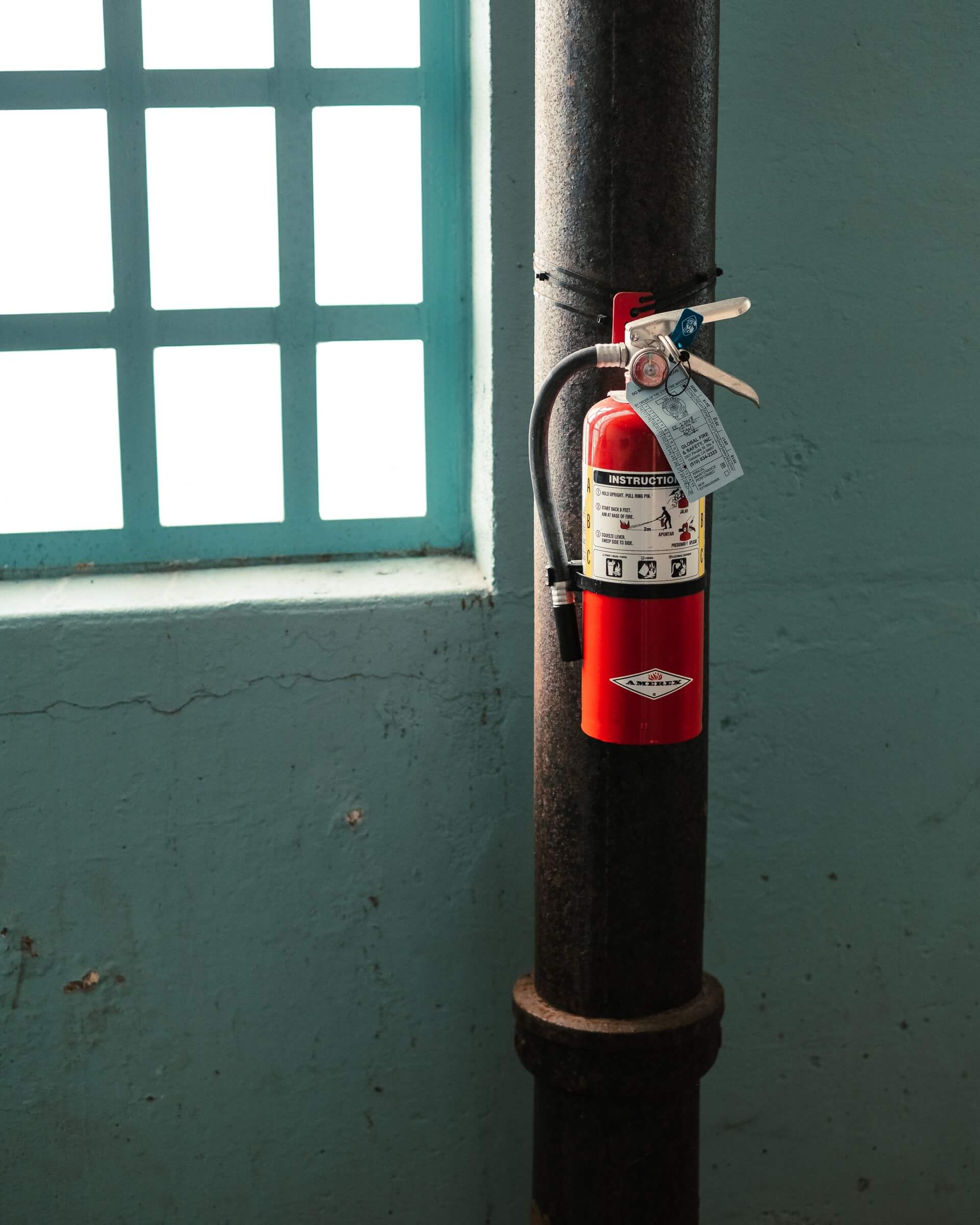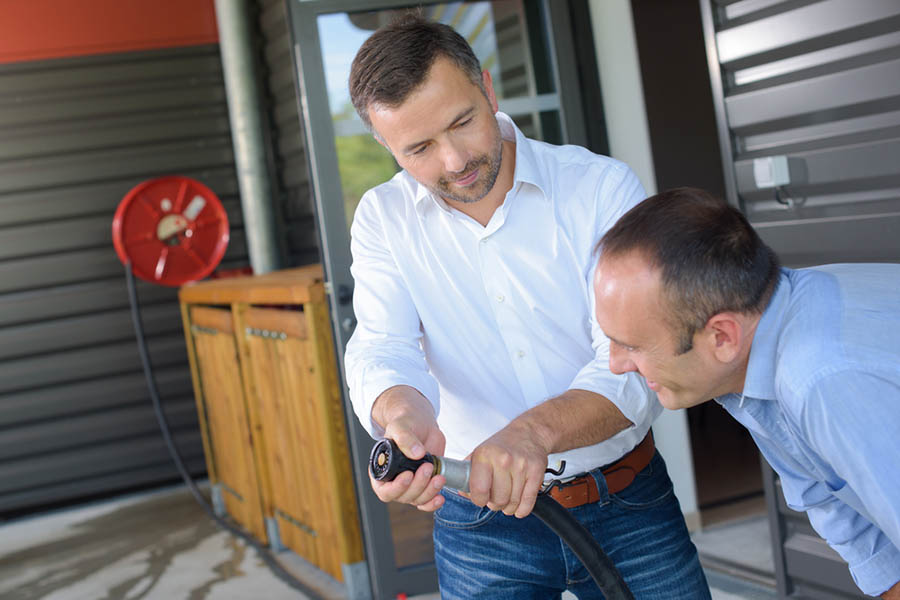Characteristics of different fire extinguishers
Most home fire extinguishers are of the ABC variety and come in sizes from 5-20 pounds. The weight refers to how much firefighting material they hold; their actual weight in the hand is heavier.
Also found on household extinguishers is a label indicating the severity of the fires they can handle. The higher the number, the larger the size of the fire they can handle. This is called a UL rating.
Always look for a fire extinguisher that features the “UL” or “ULC” certification, as this denotes that it’s been tested and approved by Underwriters Laboratories, a safety certification organization.
There is one UL rating for Class A extinguishers, and another for Class B and C extinguishers. Here’s what to look for on your fire extinguisher label:
- The UL Listed or ULC Listed icon. These tell you that the fire extinguisher is UL-approved.
- The UL rating. Class A has a different rating from Class B and C. An ABC extinguisher will show both ratings side-by-side.
The “1-A” is the Class A rating, with the 1 being the water equivalency. 1 is equal to 1.25 gallons of water. On most home fire extinguishers, this number rangers from 1 to 5, but can be higher on a large extinguisher.
The “10-B:C” part of the label is the Class B and C rating. The number in this part tells you how many square feet of fire it can extinguish. The example above is a small fire extinguisher, which is capable of extinguishing 10 square feet of fire. This number can range from 1 to 40.
Fire extinguisher inspections and maintenance
Fire extinguishers do need regular inspections and maintenance. You don’t want to wait for a fire to break out to find your extinguisher has failed.
“[Fire extinguishers] do need to be maintained on a regular basis, so you’ll want to check with the manufacturer specifications on how often they need to be used for maintenance,” says Roydhouse. “You can find this information on the tag located on each individual fire extinguisher.”
You should check all standard extinguishers monthly and have them serviced annually by a professional.
During your monthly checks, inspect the pressure gauge to make sure the needle is in the green zone; if not, fix or replace the unit.
Make sure the safety pin is still present, and the cylinder is free of damage. If it is damaged, have a professional examine the unit.
As well, you’ll generally need to have your extinguisher refilled or recharged about every five years.
“After a while when they sit, they have to be hydrostatic tested,” says Roydhouse. “Sometimes the chemical settles and needs to be dumped out and recharged.”
Make sure you keep up inspections and service so you can rely on your extinguisher at any time. Fires don’t announce themselves in advance and you need to be prepared.
How to use your extinguisher
Whichever type of extinguisher you purchase, be sure that everyone in the family knows where it is stored—preferably near an exit to the room—and that everyone who is old enough knows how to use it. Read the instructions carefully and review them prior to your annual family fire drill.
“If you don’t know how to use a fire extinguisher and want to learn how before you actually need it, the nice thing is that you can stop by any fire station and they’ll be glad to show you the correct way to use a fire extinguisher,” says Roydhouse.
“Also, in October, during Fire Prevention Week, fire departments have open houses or will host something in a town square, where they’ll bring fire equipment, light small fires, and show you how to use the different extinguishers. They’ll help you learn how to use them, so you’re comfortable.”
If you need to brush up on your fire extinguisher skills, we’ve prepared a quick guide on the steps you should familiarize yourself with.
If a fire starts, follow these steps:
1. Plan.
Quickly figure out an escape route. If the fire is too large or moving too quickly, don’t stay to fight it. Otherwise, grab the extinguisher and get ready to use it.
2. Stand Back.
To use a fire extinguisher most effectively, stand six to eight feet back from the fire.
3. Think P.A.S.S.
To use a fire extinguisher effectively, try to remember P.A.S.S.
P.A.S.S. is a handy acronym for the steps in using an extinguisher to fight a fire. P.A.S.S. stands for Pull, Aim, Squeeze, Sweep:
- Pull the fire extinguisher’s pin.
- Aim the nozzle at the base of the fire.
- Squeeze the lever or handle to discharge the contents.
- Sweep the nozzle back and forth along the base of the fire, moving it side to side until the extinguisher is empty.
While using the P.A.S.S. method remember to keep your back towards a clear exit in case the fire becomes more dangerous. Don’t use a fire extinguisher on a blaze that’s too large—don’t risk your safety.
4. Watch.
Keep an eye on the area of the fire, even if you think you’ve extinguished it. There may be embers or sparks that can catch and flare up again.
5. Call.
Once you’ve extinguished the flames, call the fire department to come and inspect the site to be sure the fire is completely out and no further action is needed.
6. Run.
If you can’t extinguish the fire yourself, leave the scene and find a safe place. Call 9-1-1 (or your local emergency number) as soon as it’s safe to do so.
“If you’re not sure whether it’s safe for you to use the fire extinguisher or you’re not sure how to use it, alert everyone else and leave the building,” says Roydhouse. “Once outside, call 911 from an outside phone source — a neighbor across the street, someone’s cell phone.”
This video will also show you how to use a fire extinguisher.
Now that you’re up to speed, be sure to purchase an extinguisher and be prepared to use it.
Common fire extinguisher mistakes
Using a fire extinguisher isn’t rocket science, but there are a few common mistakes that people make with them.
“The biggest thing you need to consider is,” says Roydhouse, “are you physically able to use the fire extinguisher? They’re not hard to use, but you’ve got to be able to lift it and hold it. So make sure to buy one that you can physically handle.”
He continues, “when you use a fire extinguisher, don’t aim the fire extinguisher directly at the centre of the fire. You want to do a sweeping motion from the outside edges and work towards the centre.
“If you do shoot right in the centre, the pressure can make the fire spread more in a larger area.”
On a similar note, make sure you’re aiming at the base of the flames, not shooting through them.
Another common mistake?
Not ensuring you’ve got a clear escape route.
“If you’re going to try to extinguish the fire, make sure you have an escape route,” says Roydhouse. “You don’t ever want to let the fire get between you and your escape route. If you extinguish the fire, you’re going to have some aftereffects like smoke and toxic fumes. Are you able to get away from those fumes? That’s the biggest thing.”
Commonly asked questions
How long does a 5 lb fire extinguisher last?
A 5-pound ABC dry chemical fire extinguisher will last about 14 seconds. A 5-pound CO2 extinguisher will last about 9 seconds.
When you pull the trigger on a fire extinguisher, you don’t have long, so make sure you’re aiming at the base of the flames when you pull the trigger.
Does a fire extinguisher expire?
Fire extinguishers do expire, and should be inspected regularly.
“Fire extinguishers, depending on the type of material inside—whether that’s a dry powder material, a carbon dioxide material, or pressurized water— will have different life expectancies, anywhere from 5-12 years,” says Roydhouse.
All fire extinguishers should feature a manufacturing date somewhere on the unit.
When should you remove extinguishers from service?
According to the Canadian Centre for Occupational Health and Safety, you should remove a fire extinguisher from service when:
- The cylinder or shell threads are damaged
- There is any visible corrosion on the unit
- The extinguisher has been exposed to fire
You should also remove a fire extinguisher from service once it’s passed its expiry date, or when a professional inspection has determined that its useful life has ended.
What is a fire tetrahedron?
The fire tetrahedron refers to the four elements that must be present for a fire to burn: fuel, heat, oxygen, and a chemical reaction.
Want to learn more? Visit our Home and Personal Safety resource centre to find more information about protecting your family and your home. Or, get an online quote in under 5 minutes and find out how affordable personalized home insurance can be.
About the expert: Chuck Roydhouse
Chuck Roydhouse is a retired professional firefighter, owner of Clean Sweep of Anne Arundel County, and President of CSIA (Chimney Safety Institute of America). He has a degree in Fire Science & Safety from Shepherd University and 25 years of experience as a career firefighter. Chuck has been serving the chimney industry for 30 years as a CSIA Master Chimney Sweep.



